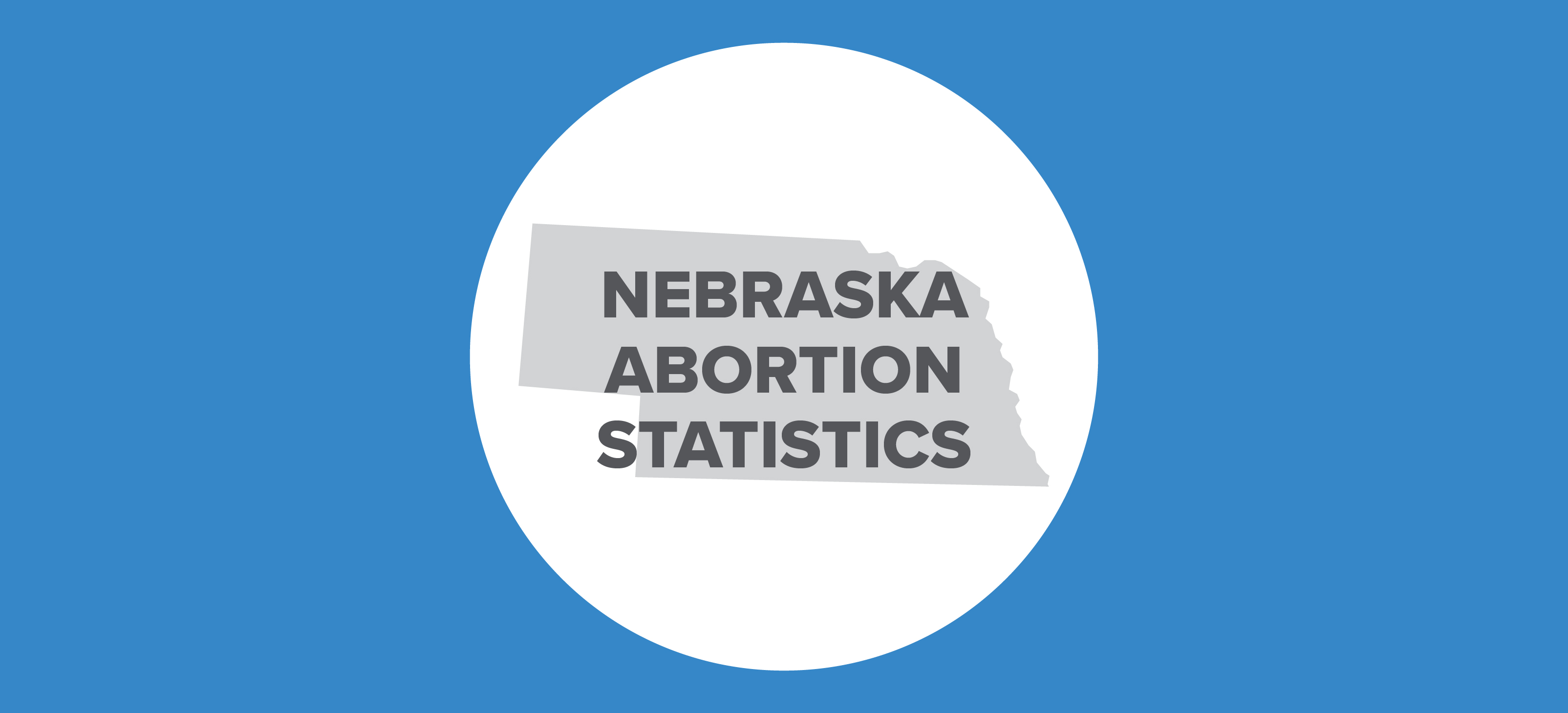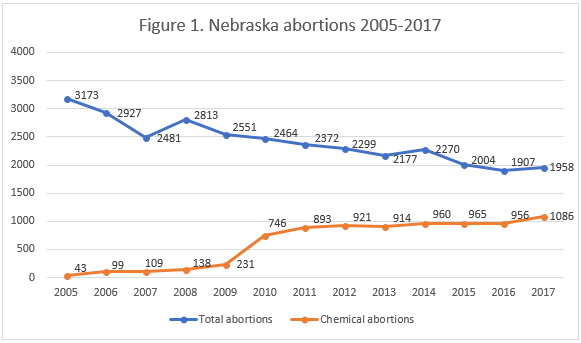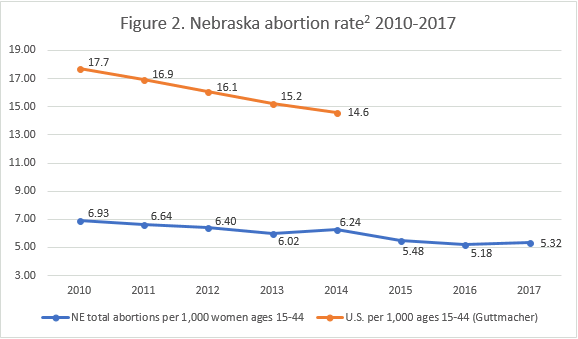Abortion Reporting: Nebraska (2017)

Nebraska’s annual abortion report for 2017, published online by the state Department of Health and Human Services, was published ahead of schedule in April 2018. Nebraska was the fifth state to release its abortion report for 2017, further indication that prompt reporting of annual data is feasible.
Changes in Nebraska Abortions, 2016-2017

Abortion Totals and Trends
Abortions increased in Nebraska from the previous year. There were 1,958 abortions performed in the Cornhusker State in 2017, up three percent from 1,907 in 2016. Chemical abortions rose by an even greater percentage, increasing by 14 percent from 956 in 2016 to 1,086 in 2017. Since 1980, total Nebraska abortions have fallen by 68 percent. From 2001, the first full year after the U.S. Food and Drug Administration approved the use of mifepristone as an abortion drug, chemical abortions in Nebraska have increased by almost 800 percent. Chemical abortions made up 55 percent of all abortions performed in Nebraska during 2017. While Nebraska does not report the state abortion rate, CLI estimates that the rate increased from 5.18 abortions per 1,000 Nebraska women of childbearing age in 2016 to 5.32 in 2017.
State Report Summary
Most of the women getting abortions in Nebraska during 2017 were residents (89 percent). There were 207 women from out-of-state, including 158 women from Iowa, who made up eight percent of the total. A majority of women (59 percent) were in their twenties, followed by 28 percent in their thirties and nine percent age 19 or younger. Sixty-eight women were in their 40s, while six girls were under the age of 15. Seventy percent of the reported abortions in Nebraska were performed on women who identified themselves as white, and 17 percent were performed on women who identified as black. However, women could select more than one race, meaning some women may have included themselves in more than one racial category.
Similar to women in other states, the largest group of women getting abortions in Nebraska had completed high school, but not college. Ten percent had not finished high school, while 45 percent reported high school as their highest level of education and 30 percent had completed some college. Eleven percent had a college degree.
Most women, 82 percent, were not married. Seventeen percent were married, but marital status was not indicated for 27 women. For many women, their abortions represented their first experience with pregnancy – 31 percent reported zero previous pregnancies. However, more than half had already given birth, with 23 percent with one previous live birth and 36 percent with two or more. Most women, 66 percent, reported no previous abortions. Twenty-four percent reported one prior abortion, and 10 percent reported more than one.
Nebraska reports both gestational age and probable post-fertilization age (PPF age). PPF age measures the age of the baby from fertilization and is usually two weeks less than gestational age. In 2017, most abortions were performed at six weeks PPF age or earlier (63 percent). Seventeen percent of the babies killed by abortion were between seven and eight weeks old, and 10 percent were between nine and 10 weeks post-fertilization. Six percent of abortions were performed between 11 and 12 weeks. Forty-six abortions occurred between 13 and 15 weeks PPF, and 38 were performed from 16 to 19 weeks. No babies older than 19 weeks post-fertilization were reported to have been aborted. Abortion in Nebraska is prohibited at or after 20 weeks post-fertilization, unless the life or a major bodily function of the mother is in danger or the abortion is to preserve the life of an unborn child. If an abortion at or after 20 weeks PPF is performed, the doctor must answer a list of detailed questions about why the abortion was necessary and whether the unborn baby was given the best chance for survival. None of these questions were answered in 2017 because no abortions were performed at or after 20 weeks post-fertilization. While the requirement to estimate post-fertilization age is waived in emergencies, no such emergencies were reported in 2017, and PPF age was estimated before every abortion.
Only one abortion was reported to have caused complications in 2017, resulting in a hemorrhage and another unspecified complication1. However, the experiences of other states have demonstrated that complications from abortion are chronically underreported, and it is likely that many complications were not reported to the Nebraska Department of Health. Nine doctors reported abortions in Nebraska during 2017. Nebraska’s abortion report divides doctors into three categories: those who perform fewer than 25 abortions per year, those who perform between 25 and 1,000 abortions per year, and those who perform more than 1,000 abortions per year. In 2017, seven doctors fell into the first category, together performing nine abortions. The eighth doctor performed 888 abortions, and the ninth performed 1,061 abortions, an average of almost three a day.
Nebraska is one of just a few states to report the physical characteristics of the babies killed by abortion, asking doctors to record the weights and lengths of the unborn children who were aborted. However, most babies were not measurable. Of the 992 babies whose length was reported, the majority (761 babies) were under 29 millimeters long, or approximately one inch. There were 176 babies between 30 and 59 millimeters long, or 2.3 inches, and 55 who were 60 millimeters or over. Weight was not measurable for most babies; 74 percent were not weighed. There were 431 babies under 100 grams, or 3.5 ounces. Sixty-eight aborted babies weighed between 100 and 399 grams, and one weighed more than 400 grams (14 ounces).
Before almost every abortion, ultrasounds were used to determine probable post-fertilization age. Nebraska law requires that if an ultrasound is used in preparation for an abortion, the woman must be given the opportunity to view the ultrasound and have it explained to her. The abortion report does not indicate whether any of the women undergoing abortions elected to view their ultrasounds. Every woman gave informed consent before her abortion except for one; in this case, the informed consent requirement was waived because of a medical emergency. In Nebraska, parental consent is required before a minor girl under the age of 18 can get an abortion, unless the requirement is waived by a judge who determines whether the girl is mature enough to give her own informed consent or unless the girl is the victim of abuse. Nebraska’s abortion report shows that consent was obtained in 72 cases, and no exceptions were made. The report does not state why consent for minors’ abortions was obtained in 72 cases, but only 63 minor girls underwent abortions. One possibility is that some girls obtained parental consent but decided not to go through with the abortion.
Reasons for Abortion
Nebraska is one of just a few states to report why women choose abortion. Women may provide more than one reason for their decision, so each abortion may have been performed for multiple reasons. Consistent with the other states that CLI has reviewed – and with Nebraska’s 2016 abortion report – most abortions were not performed for “difficult” cases, such as rape, incest, danger to the life of the mother, or the health of the baby. Instead, more than half, 53 percent, of the women obtaining abortions in Nebraska said that they were choosing abortion because they did not use contraception. Eleven percent cited contraceptive failure, and four percent chose abortion for socio-economic reasons. Two percent of the total, 34 abortions, were performed because of the mothers’ mental health. In comparison, 51 abortions were performed because of the mother’s physical health, and 14 because the mother’s life was in danger. Fetal anomaly was selected as a reason for 16 abortions, while 17 abortions were because of sexual assault and two because of incest. No reason was provided for 579 abortions, or 30 percent of the total.
State Ranking
In a CLI study of state abortion reporting, Nebraska ranked in the top 10 states, but could strengthen its reporting by including more information. With so many women citing non-use of contraception – or contraception failure – as a reason for abortion, Nebraska would do well to include data on contraception use and the types of contraceptives chosen. Nebraska could also add information on previous miscarriages to women who get abortions, data it already collects, to give a more complete view of women’s pregnancy histories as other states do. The state could also widen its complication reporting to include complications identified after the woman leaves the abortion clinic, and any resulting deaths. Since only two doctors perform the vast majority of the abortions in Nebraska, the state could provide more details on the specialties of doctors performing abortions and the facilities where abortions occur. Similarly, Nebraska could track the methods of payment used to fund abortion.


- Statistics on abortion complications reported here represent a minimal number of deaths and complications, as this data is collected in a non-systematic and non-verifiable way. As such, this data cannot be used to calculate either an accurate abortion mortality rate, nor an accurate abortion complication rate for the state.
- Nebraska does not report the state abortion rate. Rates were calculated by the Charlotte Lozier Institute using population estimates from the United States Census Bureau. The rates were calculated using the following formula: (total number of abortions performed in Nebraska ÷ number of resident women ages 15-44) x 1,000. The rate for 2017 used population estimates for 2016, the most recent year available.
























